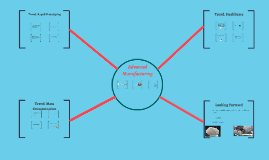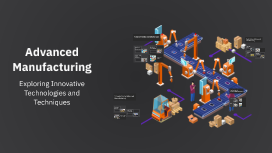Advanced Manufacturing
Transcript: Future Trends and Challenges Applications of Advanced Manufacturing Aerospace Industry Workforce Development Sustainability in Manufacturing Healthcare Devices Advanced manufacturing enables the aerospace sector to produce lighter, stronger parts via 3D printing and composite materials. Enhanced precision reduces manufacturing waste, leading to significant cost savings and improved aircraft performance. Advanced manufacturing allows for the production of customized implants and prosthetics using biocompatible materials. The capability for rapid iteration accelerates the development of medical devices, improving patient care. As technology evolves, the manufacturing workforce must adapt through continuous training and reskilling. A projected 2.4 million manufacturing jobs are expected to go unfilled by 2028 due to skills shortages. Sustainability is becoming a cornerstone of modern manufacturing, with companies adopting eco-friendly materials and processes. Manufacturing accounts for around 20% of global carbon emissions, highlighting the urgent need to transition to greener practices. Automotive Sector Consumer Electronics The automotive industry utilizes advanced manufacturing for rapid prototyping and production of components. Technologies like robotics and IoT integration facilitate smarter manufacturing processes, culminating in vehicles that are safer and more efficient. In consumer electronics, advanced manufacturing ensures high precision and efficiency in producing complex circuit boards and components. Innovations like automation reduce production costs and improve product reliability, catering to consumer demand. Supply Chain Resilience Cybersecurity Concerns Advanced Manufacturing Supply chain resilience is critical in mitigating disruptions caused by global events. Advanced technologies, such as AI and big data, are utilized to enhance visibility and responsiveness in supply chains. With increasing digitization, cybersecurity risks pose a significant threat to manufacturing systems. Around 30% of manufacturers experienced cyber incidents in the past year, emphasizing the need for robust security measures. Technologies in Advanced Manufacturing Exploring Innovative Technologies and Techniques Introduction to Advanced Manufacturing Additive Manufacturing Automation and Robotics Additive manufacturing, or 3D printing, creates components layer by layer, allowing for complex geometries and reduced waste. It enables rapid prototyping and customization, with applications ranging from healthcare to aerospace. Automation and robotics streamline manufacturing processes by enhancing precision and reducing human error. Employing machines leads to increased productivity and operational efficiency in repetitive tasks across industries. Internet of Things (IoT) Artificial Intelligence and Data Analytics The Internet of Things (IoT) connects machinery and systems, facilitating real-time data collection and analysis. This connectivity enhances decision-making, predictive maintenance, and supply chain management in manufacturing. Artificial Intelligence and data analytics optimize production processes by predicting trends and improving quality control. AI enables manufacturers to analyze vast datasets for more informed and strategic decisions. Definition of Advanced Manufacturing Advanced manufacturing refers to the use of innovative technologies and processes, such as automation, robotics, and artificial intelligence, to produce goods efficiently and with high precision. It integrates advanced materials and knowledge-driven approaches to enhance product quality. Key Drivers of Transformation The key drivers of transformation in advanced manufacturing include technological advancements, globalization, and the demand for customized products. These factors push companies to adopt smart manufacturing practices for better efficiency and reduced time-to-market. Importance in the Modern Economy Advanced manufacturing is pivotal for economic growth and competitiveness. It drives job creation, enhances product innovation, and contributes to sustainability initiatives, making industries more resilient in a rapidly changing market.

















